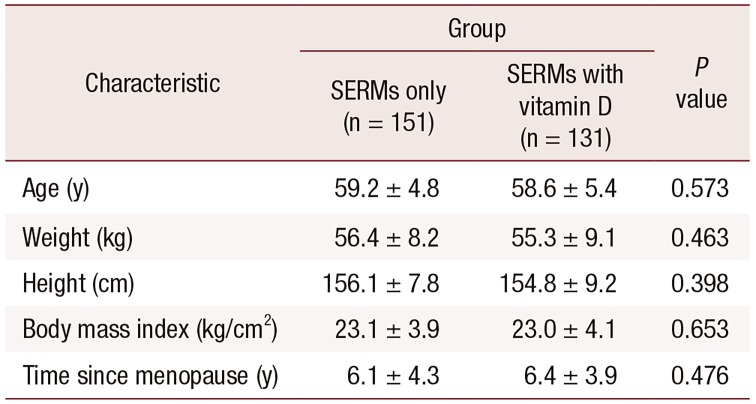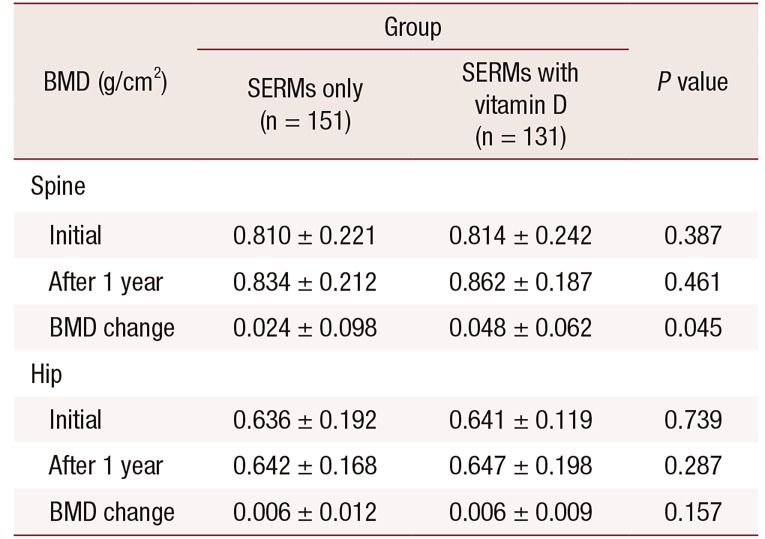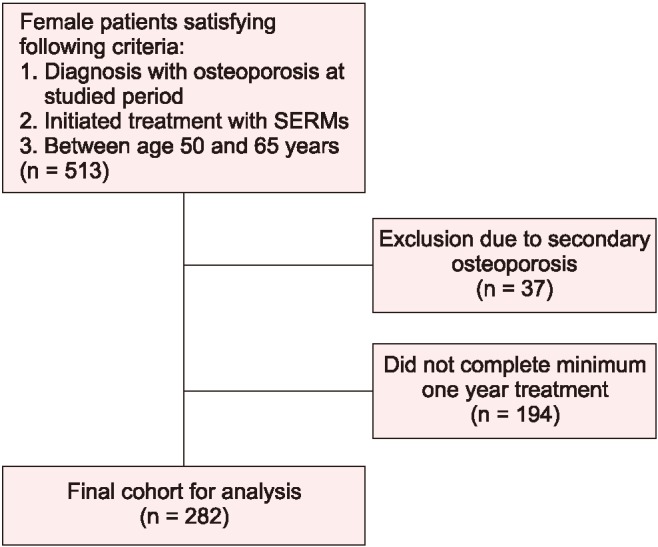1. NIH consensus development panel on osteoporosis prevention, diagnosis, and therapy, March 7-29, 2000: highlights of the conference. South Med J. 2001; 94:569–573. PMID:
11440324.
2. Astrand J, Thorngren KG, Tägil M, Akesson K. 3-year follow-up of 215 fracture patients from a prospective and consecutive osteoporosis screening program. Fracture patients care! Acta Orthop. 2008; 79:404–409. PMID:
18622846.
3. Um MJ, Cho EA, Jung H. Combination therapy of raloxifene and alendronate for treatment of osteoporosis in elderly women. J Menopausal Med. 2017; 23:56–62. PMID:
28523260.

4. Centre for Metabolic Bone Diseases, University of Sheffield. Fracture Risk Assessment Tool (FRAX®). Sheffield: University of Sheffield;cited 2018 Nov 25. Available from:
https://www.sheffield.ac.uk/FRAX/.
5. Schneider EL, Guralnik JM. The aging of America. Impact on health care costs. JAMA. 1990; 263:2335–2340. PMID:
2109105.

6. Chrischilles E, Shireman T, Wallace R. Costs and health effects of osteoporotic fractures. Bone. 1994; 15:377–386. PMID:
7917575.

7. Chappard D, Baslé MF, Legrand E, Audran M. New laboratory tools in the assessment of bone quality. Osteoporos Int. 2011; 22:2225–2240. PMID:
21347743.

8. Sunyecz JA. The use of calcium and vitamin D in the management of osteoporosis. Ther Clin Risk Manag. 2008; 4:827–836. PMID:
19209265.

9. Kim TH, Lee HH, Kim JM, Choi SD, Lee A, Hwang SY, et al. Expression of vitamin D receptor in seminal vesicles of cholesterol formula mice. J Menopausal Med. 2015; 21:89–92. PMID:
26357646.

10. Oh J, Weng S, Felton SK, Bhandare S, Riek A, Butler B, et al. 1,25(OH)2 vitamin d inhibits foam cell formation and suppresses macrophage cholesterol uptake in patients with type 2 diabetes mellitus. Circulation. 2009; 120:687–698. PMID:
19667238.
11. Lukert B, Higgins J, Stoskopf M. Menopausal bone loss is partially regulated by dietary intake of vitamin D. Calcif Tissue Int. 1992; 51:173–179. PMID:
1422960.

12. Villareal DT, Civitelli R, Chines A, Avioli LV. Subclinical vitamin D deficiency in postmenopausal women with low vertebral bone mass. J Clin Endocrinol Metab. 1991; 72:628–634. PMID:
1997517.

13. Adami S, Giannini S, Bianchi G, Sinigaglia L, Di Munno O, Fiore CE, et al. Vitamin D status and response to treatment in post-menopausal osteoporosis. Osteoporos Int. 2009; 20:239–244. PMID:
18551242.

14. Sadat-Ali M, Al Elq AH, Al-Turki HA, Al-Mulhim FA, Al-Ali AK. Influence of vitamin D levels on bone mineral density and osteoporosis. Ann Saudi Med. 2011; 31:602–608. PMID:
22048506.

15. Park JH, Hong IY, Chung JW, Choi HS. Vitamin D status in South Korean population: seven-year trend from the KNHANES. Medicine (Baltimore). 2018; 97:e11032. PMID:
29952942.
16. Tuppurainen MT, Komulainen M, Kröger H, Honkanen R, Jurvelin J, Puntila E, et al. Does vitamin D strengthen the increase in femoral neck BMD in osteoporotic women treated with estrogen? Osteoporos Int. 1998; 8:32–38. PMID:
9692075.

17. Dawson-Hughes B, Harris SS, Krall EA, Dallal GE, Falconer G, Green CL. Rates of bone loss in postmenopausal women randomly assigned to one of two dosages of vitamin D. Am J Clin Nutr. 1995; 61:1140–1145. PMID:
7733040.

18. Dawson-Hughes B, Dallal GE, Krall EA, Harris S, Sokoll LJ, Falconer G. Effect of vitamin D supplementation on wintertime and overall bone loss in healthy postmenopausal women. Ann Intern Med. 1991; 115:505–512. PMID:
1883119.

19. Islam MZ, Shamim AA, Viljakainen HT, Akhtaruzzaman M, Jehan AH, Khan HU, et al. Effect of vitamin D, calcium and multiple micronutrient supplementation on vitamin D and bone status in Bangladeshi premenopausal garment factory workers with hypovitaminosis D: a double-blinded, randomised, placebo-controlled 1-year intervention. Br J Nutr. 2010; 104:241–247. PMID:
20193095.

20. Reid IR, Bolland MJ, Grey A. Effects of vitamin D supplements on bone mineral density: a systematic review and meta-analysis. Lancet. 2014; 383:146–155. PMID:
24119980.

21. Cho YH, Um MJ, Kim SJ, Kim SA, Jung H. Raloxifene administration in women treated with long term gonadotropin-releasing hormone agonist for severe endometriosis: effects on bone mineral density. J Menopausal Med. 2016; 22:174–179. PMID:
28119898.

22. Clemett D, Spencer CM. Raloxifene: a review of its use in postmenopausal osteoporosis. Drugs. 2000; 60:379–411. PMID:
10983739.
23. Díez JL. Skeletal effects of selective oestrogen receptor modulators (SERMs). Hum Reprod Update. 2000; 6:255–258. PMID:
10874570.
24. Sato Y, Tando T, Morita M, Miyamoto K, Kobayashi T, Watanabe R, et al. Selective estrogen receptor modulators and the vitamin D analogue eldecalcitol block bone loss in male osteoporosis. Biochem Biophys Res Commun. 2017; 482:1430–1436. PMID:
27974229.

25. Shin CJ, Kim S, Choi CS, Shin HC, Kwon YJ. Effectiveness of osteoporosis drug in postmenopausal women with spinal compression fracture: combined consecutive therapy of Teriparatide and Raloxifene versus Bisphosphonate single. Korean J Neurotrauma. 2016; 12:123–127. PMID:
27857920.

26. Kanis JA, Johnell O, Black DM, Downs RW Jr, Sarkar S, Fuerst T, et al. Effect of raloxifene on the risk of new vertebral fracture in postmenopausal women with osteopenia or osteoporosis: a reanalysis of the Multiple Outcomes of Raloxifene Evaluation trial. Bone. 2003; 33:293–300. PMID:
13678769.
27. Bjarnason NH, Sarkar S, Duong T, Mitlak B, Delmas PD, Christiansen C. Six and twelve month changes in bone turnover are related to reduction in vertebral fracture risk during 3 years of raloxifene treatment in postmenopausal osteoporosis. Osteoporos Int. 2001; 12:922–930. PMID:
11808544.

28. Morii H, Ohashi Y, Taketani Y, Fukunaga M, Nakamura T, Itabashi A, et al. Effect of raloxifene on bone mineral density and biochemical markers of bone turnover in Japanese postmenopausal women with osteoporosis: results from a randomized placebo-controlled trial. Osteoporos Int. 2003; 14:793–800. PMID:
12955333.

29. Dane C, Dane B, Cetin A, Erginbas M. Comparison of the effects of raloxifene and low-dose hormone replacement therapy on bone mineral density and bone turnover in the treatment of postmenopausal osteoporosis. Gynecol Endocrinol. 2007; 23:398–403. PMID:
17701771.








 PDF
PDF ePub
ePub Citation
Citation Print
Print




 XML Download
XML Download